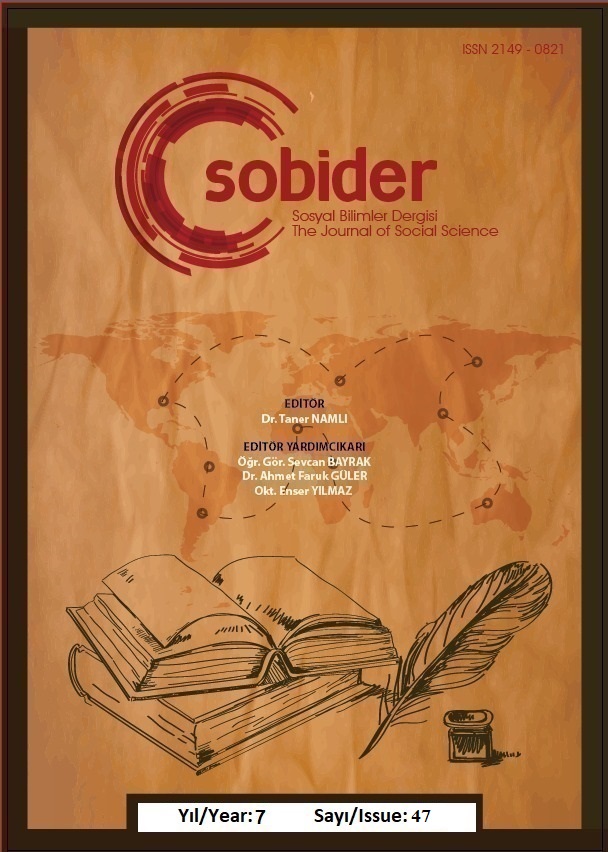Author :
Abstract
Toprak, yaşamsal öneminin dışında, iktisadi ve kültürel açıdan da insanı kendine bağımlı kılan unsurların başında gelmektir. Toprağa bağlı üretim sonucu oluşan ticari ilişkiler, ekonomik faaliyetleri artırarak kırsal yaşama alternatif yaşam alanları yaratarak bugünkü kentlerin yapılanmasına zemin hazırlamıştır. Böylelikle kent ve kırsal alan coğrafya üzerinde hem kültürel hem de ekonomik açıdan ayrışmıştır. Tüm bu toplumsallaşma süreçleri aynı zamanda sosyal sınıfları meydana getirmiş ve sahiplenilen toprak, korunması gereken bir değer olarak devletlerin oluşmasında önemli rol oynamıştır. Ortaçağ Avrupası’na hakim feodal sistem de bu doğrultuda ortaya çıkmıştır. İktisadi açıdan toprağa bağımlı Ortaçağ Avrupa’sına hakim olan feodal sistemin, tüm yükünü köylü ve toprak emekçi üstlenmiştir. Ancak bu yüke rağmen köylüler, aristokrasi ve burjuva tarafından sosyal sınıf açısından değersizleştirilmiş ve sanat alanında da görünmez kılınmıştır. 1789 Fransız Devrimiyle başlayan süreçle birlikte, içinde köylülerinde olduğu sınıfsal çatışmalar yaşanmış ve tüm süreçlerin etkisi de sanat alanına yansımıştır. Realizm akımı bu süreçlerin bir sonucu olarak ortaya çıkmıştır. Realizmin öncülerinden olan François Millet, ele aldığı konular açısından devrim niteliğinde bir çıkış yapmıştır. Sanat tarihinin yüzyıllardır görünmez kıldığı köylü ve toprak emekçisinin zorlu hayatını resimlerine konu edinen sanatçı, sanat tarihinin idealize edilmiş yaşamların karşısına, yaşanan gerçeği koymuştur. Bu çalışmada amaçlanan; François Millet’nin çalışmalarını toprak ve emek bağlamında dönemin tarihsel koşulları ile birlikte ele almak ve bu doğrultuda eser analizi yapmaktır.
Keywords
Abstract
Soil is one of the primary factors that also make people dependent on itself culturally and economically apart from its vital importance. The commercial relations which were formed as a result of soil-dependent production have created a basis for structuring today's cities by increasing the economic activity and creating an alternative living space for rural life. So, the rural and city area have separated from each other both economically and culturally on geography. All these socialization processes created social classes at the same time and the owned land played an important role in the formation of states as a necessary value which was needed to be protected. The feudal system ruling Medieval Europe also emerged in this direction. Peasant and land labourers took over the entire burden of the feudal system which dominated economically soil-dependent Medieval Europe. However, the peasants were trivialized by the aristocracy and bourgeoisie in terms of the social class despite this burden and made invisible in the field of art. Together with the process started with the French Revolution 1789, there were class conflicts including villagers and the effect of all process reflected in the field of art. The realism movement emerged as a result of these processes. François Millet who is one of the pioneers of realism made a revolutionary breakthrough in terms of the issues that he dealt with. The artist, who handled the difficult life of the peasant and land workers that was made invisible in the art history for centuries in his pictures, put the reality in the face of idealized lives of art history. The purpose of this study is to deal with the works of François Millet together with the historical conditions of the period in terms of soil and labour and to analyze works in this direction.
Keywords
- Akbulut, D. (2007). Açık Beden, İstiklal Kitapevi, İstanbul.
- Aksoy, H. (1999). Marksizmin Temel Kavramları, Tohum Yayıncılık, İstanbul.
- Arifoğlu, Y. (2019). “Toprak ve İnsan: Birkaç Edebi Metinde ve Avesta’ da Toprağın Yansıması”, Artvin Çoruh Üniversitesi Uluslararası Sosyal Bilimler Dergisi, Cilt 5, Sayı 1, 53-60.
- Bloch, M. (1995). Feodal Toplum, M.A. Kılıçbay (Çev), Gece Yayınevi, Ankara.
- Çalışırlar, A (1986). Gerçekçilik Estetiği, De Yayınevi, İstanbul.
- Gombrich E.H. (2011). Sanatın Öyküsü, Erol-Ömer Erduran (Çev.), Remzi Kitapevi, İstanbul.
- Fischer E. (2010). Sanatın Gerekliliği, (Çev.), Cevat Çapan, 11. Basım, Payel Yayıncılık, İstanbul.
- Peker M. U. (2015). Tarımdan Sonra İnsan, Apelasyon Dergisi, Sayı, 21.
- Ülgen, P. (2010). “Ortaçağ Avrupasında Feodal Sisteme Genel Bir Bakış” Mukaddime Dergisi, Cilt 1, Sayı 1, 1-18.
- Turani, A. (1992). Dünya Sanat Tarihi, Remzi Kitapevi, İstanbul.
- Tarih Ekonomi Ve Siyaset Araştırmaları Derneği. Erişim Adresi (20.05.2020): https://www.tesadernegi.org/fransiz-aydinlanmasi-ii.html?487d50&487d50
- Sanat Magazin. (27.12.2012 ). Erişim Adresi 25.05.2020: 0http://wall- zilla.blogspot.com/2012/12/jean-francois-millet-ve-sabah-duas.html





